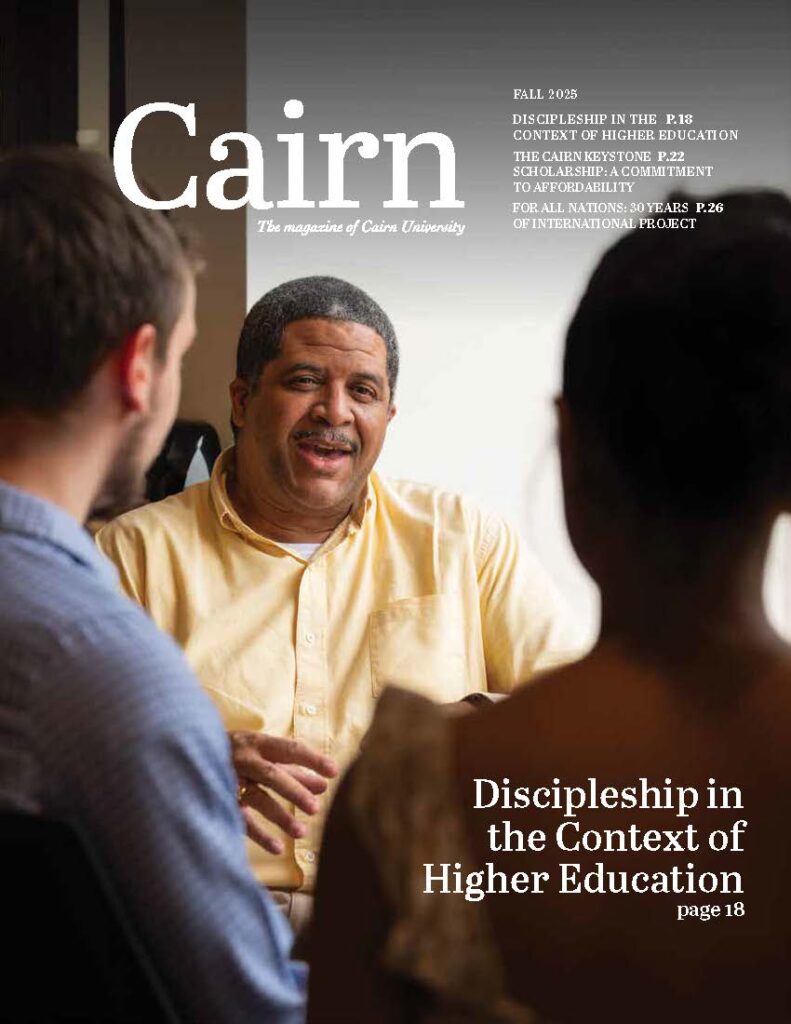Educating students to serve Christ is at the heart of Cairn University’s mission. As professors, we aim to see the truth of God, his Word, and his world formed in the hearts and minds of our students. The chief way in which we carry out this vocation of teaching is by speaking. Yet every professor also knows the value of sound scholarly literature as a crucial aid in communicating truth to his or her students.
In some cases, such as the study of Scripture or general literature, the written text is not merely an aid but the immediate subject of investigation. Even in such courses, secondary literature is frequently employed to help in understanding the primary. It is a natural development of the professor’s work to add his or her own writing—perhaps in the form of handouts or slides, at first—to the body of literature on the topic being considered. Sometimes, writing begun in the service of classroom teaching or a lecture series forms the basis for what will become a literary contribution to the field more widely. It has been a particular joy to see published works by Cairn professors coming forth with increased frequency in recent years. And yet, this literary extension of our vocation raises a question: Is literary production a legitimate piece—even if not an obligatory piece—of the university professor’s calling?
In his classic book The Idea of the University, John Henry Newman describes the purpose of the university as the “diffusion and extension of knowledge,” though he distinguishes this task from the “advancement” of knowledge through research. Jaroslav Pelikan, writing many years after Newman, notes that while Newman does not mention publishing as an explicit element of the university’s teaching responsibility, it is a natural part of the teacher’s vocation and plays a vital role in securing the university’s intellectual contribution and heritage. Pelikan asserts that publishing is “a fundamental psychological, indeed almost physiological, imperative that is rooted in the metabolism of scholarship as a sacred vocation.” His rationale for this claim is that publishing exposes the teacher’s ideas to the criticism and correction of other scholars who may even carry the results to greater lengths “by more careful and imaginative research.” Pelikan does not agree with Newman that all new research should be left to institutes and think-tanks existing independently of the university. Etienne Gilson, likewise, decries the alienation of research and teaching in which “scholars seek but do not teach, while university professors teach but do not seek.”
The medieval theologian Thomas Aquinas asked whether teaching is an activity of the contemplative life or active life. That is, is it a speculative or practical undertaking? His answer is that teaching (and by implication, writing) belongs to the active life—it is an art—but it can only be carried out from a foundation in the contemplative life. Considered in the abstract, the contemplative life, Thomas argues, is a higher form of life than the active. This is because knowledge uniquely marks eternal life (see John 17:3) and because all humans by nature desire to know. Intellectual knowledge is what distinguishes us from lower animals and is most perfective of our natures. The end of the contemplative life is the consideration of truth and the possession of it. The end of the teacher is the practical communication of truth to others. In view of this, one might imagine that the great Dominican friar would believe the life of the ivory tower intellectual was a more noble life than that of the teacher. And yet he does not draw this conclusion. Rather, he states, “Even as it is better to enlighten than merely to shine, so it is better to give to others the fruits of one’s contemplation than merely to contemplate.”
It was once a philosophical commonplace to say that the good is diffusive of itself. Perhaps something similar can be said about the truth acquired by contemplation; it is possessed best when shared with others. Aquinas is instructive on this point: “Yet that form of active life in which a man, by preaching and teaching, delivers others the fruits of his contemplation, is more perfect than the life that stops at contemplation, because such a life is built on an abundance of contemplation, and consequently such a life was chosen by Christ.”
Thomas even argues that teaching is a form of Christian charity by which, out of love for the souls of others, we work to see the good of truth formed in them. This is what good education does; it educes the forms of reality in the minds of others in order to enrich their souls. Every teacher is concerned with two subjects: the one about which he or she teaches and those to whom he or she teaches. The first subject, according to Thomas, pertains to the contemplative life, and the second is concerned with the practical.
For all this, we might still marvel at how truth is communicated from one mind to another. The forms of truth we seek to convey are immaterial. And the minds we seek to inform are not entirely passive. We cannot simply insert what we have gained by contemplation into the minds of our students in some mechanical fashion. The light of reason by which the truth is seen in the mind of man or woman is not a light even the best human teacher is able to kindle. And yet without this light, listeners and readers learn nothing, and no communication of truth occurs.
It might be tempting to despair that teaching is even realistically possible for us. It is vital, in this connection, that we understand what the human teacher does and does not do in leading others to the truth. Aquinas observes that “God alone teaches interiorly and principally.” The professor, by speaking or writing, provides external help to human reason, as a midwife facilitating the conception of truth in the minds of others. But the internal work of reason, while stimulated by the teacher’s language, is caused primarily by God, who teaches all men knowledge (see Ps 94:10). He furnishes the first principles by which all learners are enabled to see the truth for themselves.
Teachers are fellow workers together with God in bringing the minds of others into conformity with reality. Our job is to arrange the medium of words for the best possible reception in the minds of those we instruct. That arrangement of words we call teaching is not merely meant to deliver true conclusions. It is also meant to reproduce the reasoning process by which those conclusions are achieved so that those who hear or read our words can see the truth for themselves and our thinking can be evaluated and enriched by our peers. Oral and written teaching are two sides of the same coin, both using the common means of language to stimulate the senses so as to gain access for the truth to the mind and soul of our fellow man. In this regard, publishing in the form of essays, reviews, articles, or even entire books is a natural extension of the university professor’s vocation.
This article was originally published in the Spring 2023 issue of Cairn Magazine.










